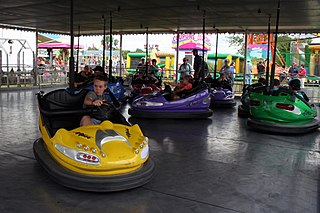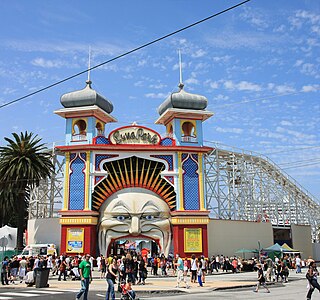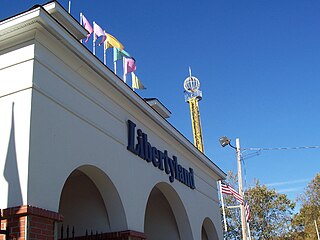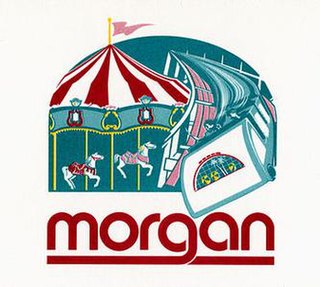
A roller coaster is a type of amusement ride employing a form of elevated railroad track that carries passengers on a train through tight turns, steep slopes, and other elements designed to produce a thrilling experience. Trains consist of open cars connected in a single line, and the rides are often found in theme parks around the world. Roller coasters first appeared in the 17th century, and LaMarcus Adna Thompson obtained one of the first known patents for a roller coaster design in 1885, based on the Switchback Railway which opened a year earlier at Coney Island.
Cedar Point is a 364-acre (147 ha) amusement park located on a Lake Erie peninsula in Sandusky, Ohio, United States. It opened in 1870 and is considered the second-oldest operating amusement park in the US behind Lake Compounce. Cedar Point, which is owned and operated by Cedar Fair, is the flagship of the company's amusement park chain. Known as "America's Roller Coast", the park features 16 roller coasters, which ranks third among amusement parks in North America behind Six Flags Magic Mountain (20) and Canada's Wonderland (18). Cedar Point's normal operating season runs from early May until Labor Day in September, which is followed by weekend-only operation through Halloween during an annual event known as HalloWeekends. Other amenities and attractions featured within the park include a one-mile-long (1.6 km) beach, an outdoor water park named Cedar Point Shores, an indoor water park named Castaway Bay, two marinas, and an outdoor sports complex called Cedar Point Sports Center.

Bumper cars or dodgems are the generic names for a type of flat amusement ride consisting of multiple small electrically powered cars which draw power from the floor or ceiling, and which are turned on and off remotely by an operator. They are also known as bumping cars, dodging cars and dashing cars. The first patent for them was filed in 1921.

Kings Dominion is an amusement park in the eastern United States, located in Doswell, Virginia, twenty miles (30 km) north of Richmond and 75 miles (120 km) south of Washington, D.C. Owned and operated by Cedar Fair, the 280-acre (1.1 km2) park opened to the public on May 3, 1975, and features more than 60 rides, shows and attractions including 13 roller coasters and a 20-acre (8.1 ha) water park. Its name is derived from the name of its sister park, Kings Island near Cincinnati, and the nickname for the state of Virginia, "Old Dominion."

Knoebels Amusement Resort is a family-owned and operated amusement park, picnic grove, and campground in Elysburg, Pennsylvania. Opened in 1926, it is United States's largest free-admission park. The park has more than 60 rides including three wooden roller coasters, three steel roller coasters, a 1913 carousel, and 2 haunted house dark rides, among more.

Valleyfair is a 125-acre (51 ha) amusement park in Shakopee, Minnesota, United States. Owned by Cedar Fair, the park opened in 1976 and now features over 75 rides and attractions including eight roller coasters. Valleyfair also has a water park called Soak City which is included with the price of admission. Cedar Point and Valleyfair were the first two parks in the Cedar Fair chain and a combination of the park names – "cedar" and "fair" – were used to name the company.
Arrow Development was an amusement park ride and roller coaster design and manufacturing company, incorporated in California on November 16, 1945, and based in Mountain View. It was founded by Angus "Andy" Anderson, Karl Bacon, William Hardiman and Edgar Morgan. Originally located at 243 Moffett Boulevard, it moved to a larger facility at 1555 Plymouth Street after Walt Disney Productions purchased one third of the business in 1960. Arrow also had offices at 820 Huff Avenue.

Luna Park Melbourne is a historic amusement park located on the foreshore of Port Phillip Bay in St Kilda, Melbourne, Victoria. It opened on 13 December 1912, with a formal opening a week later, and has been operating almost continuously ever since.
Ocean View Amusement Park was an amusement park at the end of Granby Street at Ocean View Avenue in Norfolk, Virginia, USA, opened in 1905 and operated by Jack L. Greenspoon and Dudley Cooper. The amusement park and its wooden coaster, the Rocket, appeared in the 1977 movie Rollercoaster but closed on September 4, 1978. The Rocket was destroyed as part of the making of the television program The Death of Ocean View Park in 1979.

Libertyland was an amusement park located in Memphis, Tennessee. Opened on July 4, 1976, it was located at 940 Early Maxwell Blvd. It was structured under the nonprofit 501(c)4 US tax code. It closed due to financial reasons in 2005.

Beech Bend is an amusement park, campground and automobile race track located in Warren County, in the U.S. state of Kentucky, just outside the limits of the city of Bowling Green.

Camden Park is a twenty-six acre amusement park located near Huntington, West Virginia. Established in 1903 as a picnic spot by the Camden Interstate Railway Company, it is one of only thirteen trolley parks that remain open in the United States. Whereas most trolley parks were located at the end of trolley lines, Camden Park is unusual in that it was built where riders traveling between Huntington and nearby cities would stop to change lines. Not long after opening, the park soon gained a carousel and other roadside attractions. Camden Park is West Virginia's only amusement park. The park is home to more than thirty rides and attractions, including a full-size traditional wooden roller coaster, the Big Dipper, and several other vintage rides.

Dorney Park & Wildwater Kingdom is an American amusement and water park located in Dorneyville, Pennsylvania with an Allentown mailing address. Owned and operated by Cedar Fair, the park features 64 rides, including six roller coasters, other adult and children's rides, and a waterpark, Wildwater Kingdom, with 19 water rides.

D. H. Morgan Manufacturing, later simply known as Morgan, was a manufacturer of roller coaster trains, custom amusement rides, roller coasters, children's rides and other amusement devices. Founded in 1983, the company was originally headquartered in Scotts Valley, California. In 1991, the company moved to La Selva Beach, California, and into a new 55,000-square-foot indoor manufacturing facility. That facility was later increased to 75,000 square feet. The company produced a variety of rides from 1983 until 2001, but is probably best known for its steel hyper coasters.

The Rock-O-Plane is an amusement park ride designed by Lee Eyerly in 1948 and manufactured by the Eyerly Aircraft Company of Salem, Oregon.

Paragon Park was an amusement park located on Nantasket Beach in Hull, Massachusetts. It closed in 1984.

Backlot Stunt Coaster is a launched roller coaster located at three Cedar Fair amusement parks. The first two installations opened at Kings Island and Canada's Wonderland in 2005 under the name Italian Job: Stunt Track, while the third opened at Kings Dominion in 2006 as Italian Job: Turbo Coaster. All three were themed to the climactic chase scene at the end of the 2003 film The Italian Job. Special effects were incorporated throughout the ride to reproduce the scene, although some of the effects were removed in later years. The Italian Job theme was also dropped in 2008 following Cedar Fair's acquisition of the amusement parks from Paramount.
Through its history, Hanna-Barbera has operated theme park attractions, mostly as a section in Kings Island, Carowinds, California's Great America, Kings Dominion, Canada's Wonderland, and, recently, Six Flags Great America.
Flint Park was a theme park located in the city of Flint, Michigan, USA. The park was located next to Flint Park Lake on the north side of the city. The park, settled on 40 acres of land next to the 19-acre (77,000 m2) lake, opened on May 30, 1921 and closed down in 1961. The amusement park was torn down in late 1963 or early 1964.















